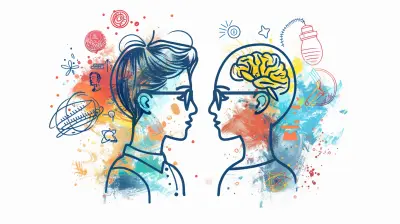The Power of Storytelling in Persuasion
18 August 2025
Let’s face it—nobody likes a lecture. You know, those dry, fact-filled snoozefests that leave you checking your watch or planning your lunch while nodding politely. Now, contrast that with a great story. Someone starts telling you about how they once convinced their boss to adopt a four-day work week using a simple bedtime story analogy—and suddenly, you’re hooked. That’s the power of storytelling in persuasion. It doesn't just knock on the door of your brain; it waltzes into your heart and makes itself at home.
But how exactly does storytelling work its magic on our decision-making brains? Why are we, as humans, hardwired to cling to a story like it's the last donut in the box? And more importantly, how can you use storytelling to persuade your audience—whether you're writing an essay, pitching an idea, or negotiating with your cat for space on the couch?
Buckle up. You're about to enter the wonderfully wild and persuasive world of storytelling.
What Makes Storytelling So Darn Effective?
Storytelling isn’t just a fancy tool for bedtime or campfires—though it really shines in those moments. It’s a centuries-old communication superpower baked into our DNA. Long before PowerPoint slides and social media threads, humans relied on stories to pass down knowledge, warn about dangers, and teach valuable lessons.So what’s happening when you listen to a story?
1. Emotional Connection
While a statistic slaps your brain with a cold, hard fact, a story gives it a big ol’ bear hug. Stories tap into our emotions. And guess what? Emotion is sticky. We remember emotional experiences far better than boring data points. A story about a student overcoming impossible odds to graduate will always stick longer than a pie chart showing dropout rates.2. Engages Multiple Parts of the Brain
When you hear a story, your brain fully lights up like Christmas. The language processing centers (okay, normal), but also the sensory cortex, motor cortex, and even areas that process taste and smell. Essentially, you don’t just hear the story—you experience it.3. Lowers Resistance
Here’s the sneaky part: stories lower defenses. When someone sells you a product or idea outright, your inner skeptic (a.k.a. your mental bouncer) shows up. But when someone shares a compelling narrative, your guard drops. You empathize first—before you even realize you’re being persuaded.
The Science Behind Storytelling: Yes, It’s Legit
Neurologically speaking, storytelling is like a cardio workout for your brain. Neuroscientist Paul Zak found increased levels of oxytocin—the “trust hormone”—in participants after they heard emotionally engaging stories. That means when someone tells you a heartfelt narrative, you’re literally more likely to trust them.And hey, we can’t ignore the mirror neurons. These little guys fire off in your brain when you watch someone else experience something in a story. So when a story character falls in love, struggles, or triumphs, your brain simulates the same feelings. It's like emotional Netflix, but without the subscription.
Storytelling in Action: Where It Works (Spoiler: Everywhere)
Think storytelling is just for movies or writers? Think again. It’s a heavy-hitter in education, politics, business, even Tinder bios. Here’s how storytelling earns its keep across multiple arenas.1. In the Classroom
Ever had a teacher who turned historical events into thrilling epics rather than reading straight from the textbook? That’s storytelling at work. Concepts wrapped in narratives become relatable. The Boston Tea Party as a rebellious prank? Suddenly, U.S. history is alive and kicking.2. In Marketing
“Buy this shampoo” = meh.“But wait—this shampoo saved my flamingo-pink hair from becoming straw!” = sold.
Brands that tell stories about people, journeys, and transformations stick with us. It’s not just a product; it’s a potential enhancement to our personal story.
3. In Public Speaking
A great speaker doesn’t rattle off bullet points—they tell a story. Think about TED Talks. The best ones start with a personal anecdote that draws you in and builds credibility. Before you know it, the speaker has tugged at your heartstrings, dropped a zinger or two, and left you inspired.4. In Everyday Persuasion
Trying to convince your roommate you should get a dog? Don’t present a spreadsheet of benefits. Tell them about the time you had a dog growing up and how it helped you overcome loneliness. Connection achieved. Argument won.
Anatomy of a Persuasive Story
Okay, so you’re fired up. Ready to unleash the power of storytelling in your next persuasive essay or boardroom pitch. But where do you start?Here’s your cheat-sheet to constructing a compelling, persuasive story.
1. A Relatable Character
Your audience should see themselves in your main character. This could be you, a fictional persona, or someone they know. The key is relatability. If they can’t invest in the protagonist, they won’t care how the story ends.2. A Conflict or Challenge
Drama, baby! Something has to go wrong. A problem must enter the scene to create tension. No one wants to hear about a perfectly happy person living a perfectly smooth life. Snooze.3. A Journey or Transformation
This is the meat of your story. How does the character try, fail, adapt, and grow? What obstacles do they overcome? This part builds momentum and draws your audience deeper.4. A Resolution
Wrap it up with a bow. The character learns something. They achieve their goal or come away changed. This is where you connect the moral of the story to your point—aka the moment of persuasion.How to Use Storytelling to Persuade (Like, Right Now)
If you’re wondering, “Cool, but how do I actually use this?”—I got you. Here’s how to start flexing those storytelling muscles today.Use Personal Stories
People trust people, not robots. Telling a short personal story makes you more relatable and credible. Don’t overthink it—your daily coffee catastrophe might just be the perfect opener for your next blog post on time management.Set the Scene
Paint a picture. Where is the story happening? What can your audience see, hear, or smell? Descriptive details make your story feel more vivid and less like a generic tale floating in a void.Use Dialogue
He said, she said…it’s all good. Dialogue brings characters to life and breaks up the monotony of narration. Plus, it keeps readers engaged like they’re eavesdropping on a juicy convo.Tie It Back to Your Message
Always land your story plane, folks. Don’t tell a fun tale and forget to connect it to your persuasive goal. The story is the bridge—you still need to lead people to the desired island.Common Mistakes to Dodge
Every great storyteller stumbles now and then. But if you can avoid these common pitfalls, your storytelling game will stay strong.- Too Long-Winded: Don’t give every detail. Cut to the juicy parts like a movie trailer.
- Too Vague: Describe, don’t generalize. “It was tough” doesn’t hit as hard as “I was eating cereal for dinner and crying into my spoon.”
- Too Preachy: Stories persuade because they show, not because they lecture.
Wrapping Up: Your Brain Craves Stories
We’re all walking story machines. Stories help us understand the world, connect with others, and make choices. So, whether you’re trying to explain quantum mechanics to a classroom, sell socks online, or convince your aunt that pineapple on pizza is a valid topping (it is, fight me), incorporate a story.Because at the end of the day, people don’t buy into logic—they buy into meaning. And stories? They’ve cornered the meaning market.
So go ahead—tell that tale. Persuade with passion. And maybe next time, skip the PowerPoint and open with, “Once upon a time
all images in this post were generated using AI tools
Category:
Communication SkillsAuthor:

Olivia Chapman
Discussion
rate this article
1 comments
Rosanna McBride
Storytelling transcends mere words; it taps into human connection.
September 4, 2025 at 3:23 AM

Olivia Chapman
Absolutely! Storytelling goes beyond language; it forges bonds that resonate emotionally, making persuasion more impactful.


